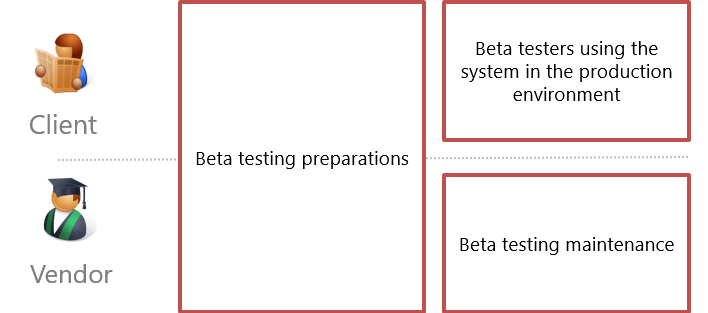The tested and refined solution is transferred to the Client’s production environment for beta testers to use during this step.
The transition from the test operation to beta testing occurs when:
•all test cases are completed successfully
•all high-priority bugs have been fixed
•the production environment is deployed in the cloud or on-site.
The beta testing step includes the following business processes (Fig. 26):
Fig. 26 Beta testing process diagram

The beta testing team includes Analysts, Developers, the Project Manager / Project Portfolio Manager, as well as the Client’s workgroup and CRM Coordinator (Fig. 27).
Fig. 27 Beta testing structure and responsibilities

Preparing for beta testing
An analyst or the a Busness Analyst Team lead updates the system’s operating procedures, based on the test operation regulations. The Vendor’s Developers are preparing the production environment. To set up integration:
•remove all test and demo data from the database
•set up integrations
•set up Client’s primary data in the system
When the production of the solution is ready, the workgroups of the Client and the Vendor test the business cases. Based on their feedback, all high priority bugs are fixed and the process moves on to the next step.
Beta testing
The second and the main stage of beta testing process begins when beta testers start working in the production environment. The Project Manager organizes the training for the workgroup. The Analysts conduct the actual training. The project manager organizes the training for the group, and the analysts conduct the actual training.
After the initial training, the Client’s CRM Coordinator tests the workgroup’s knowledge and, if necessary, gives additional training. The solution is then passed to the beta testers for further use. Depending on the size and complexity of the project, it is also possible to train users in the "baby-sitting" mode. The duration of this type of training is indicated in the project's Project’s Charter.
Note
The “baby–sitting” mode assumes individual training and support during the whole beta testing stage by the Vendor’s employees.
During the beta testing, the beta testers provide feedback about any found bugs to the CRM coordinator, who passes this information to the Vendor afterwards. Based on the feedback, a routine update is carried out every two weeks to fix all critical bugs.
See also
See also






